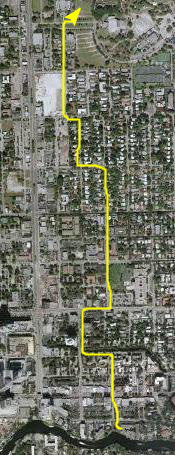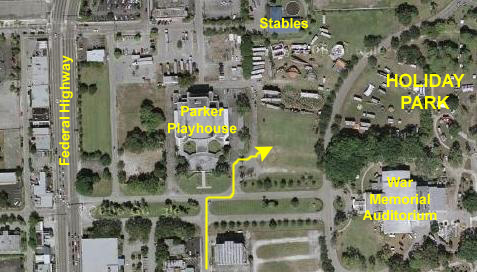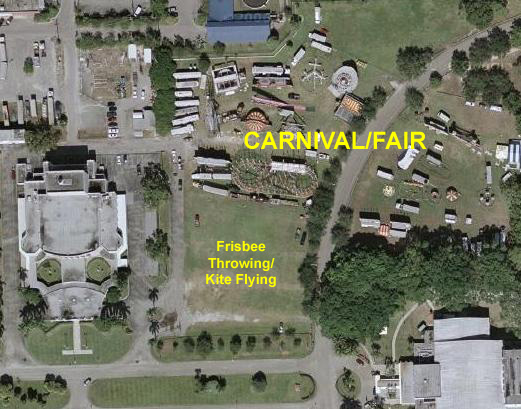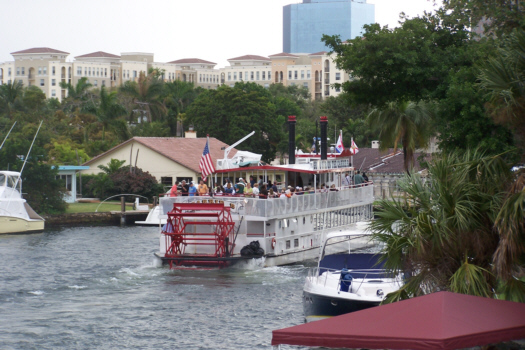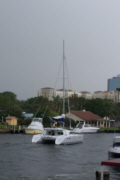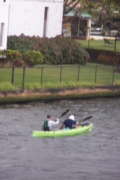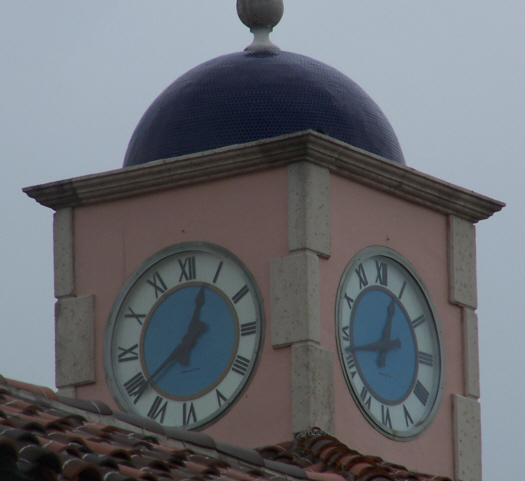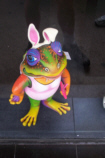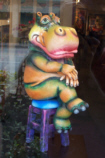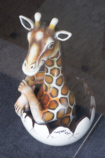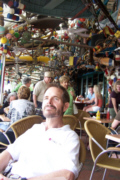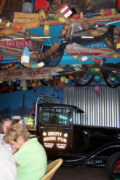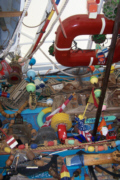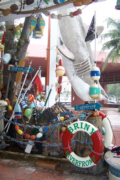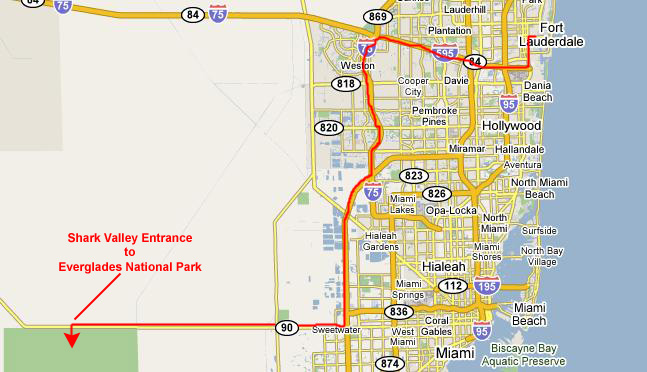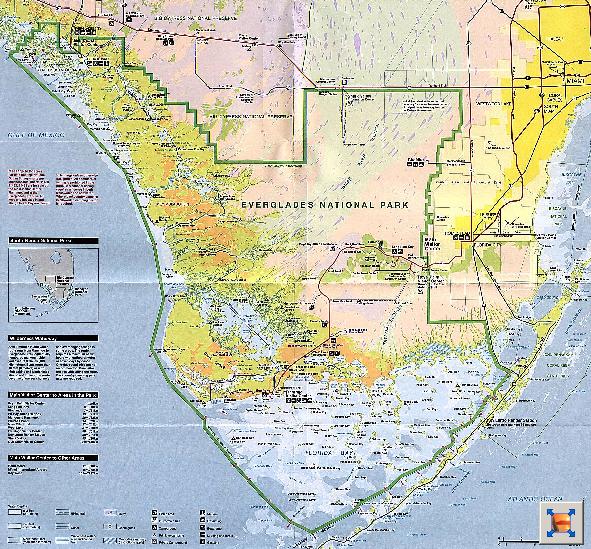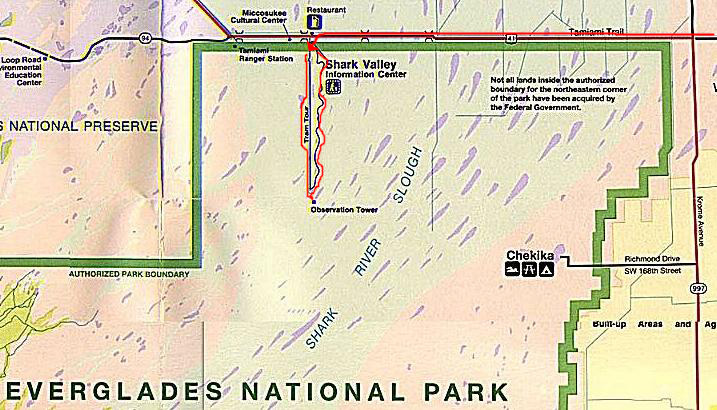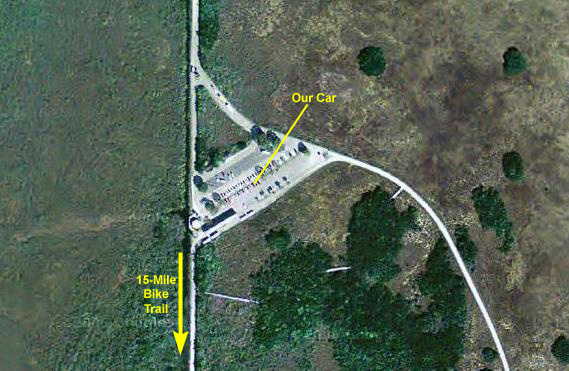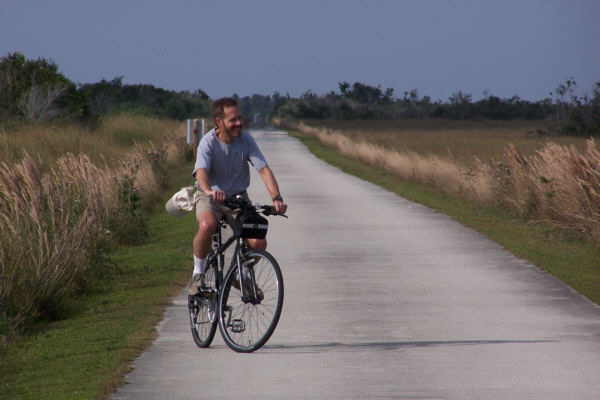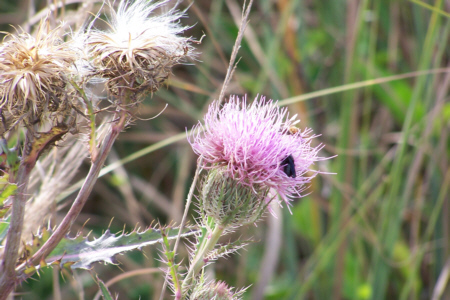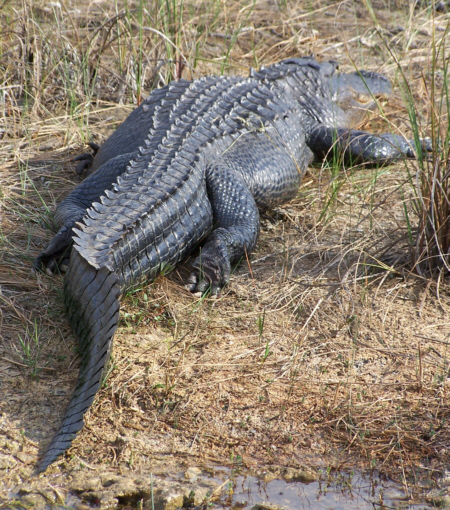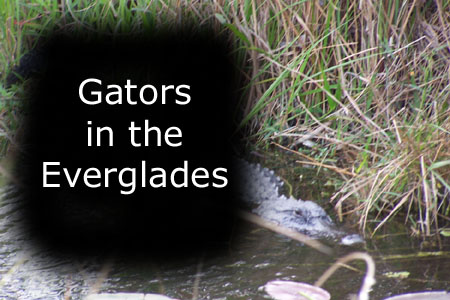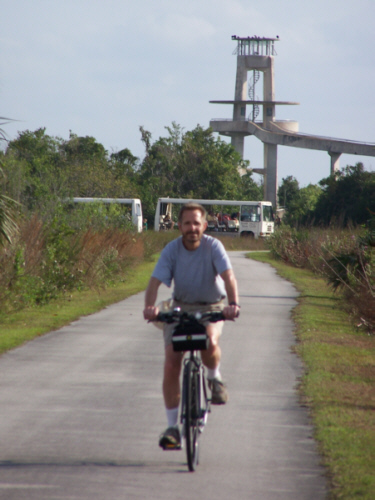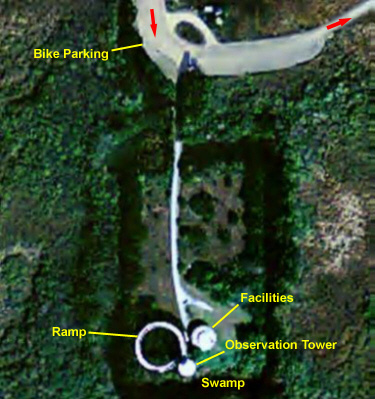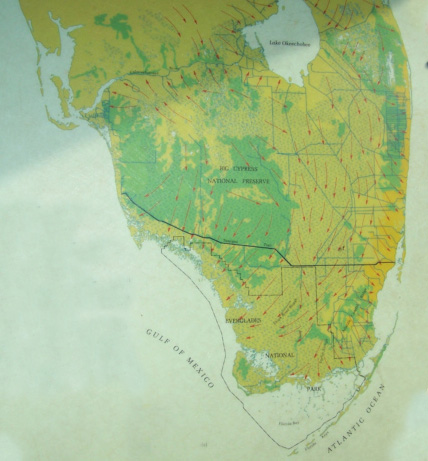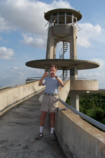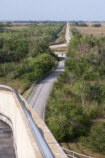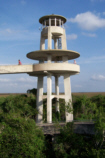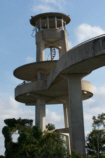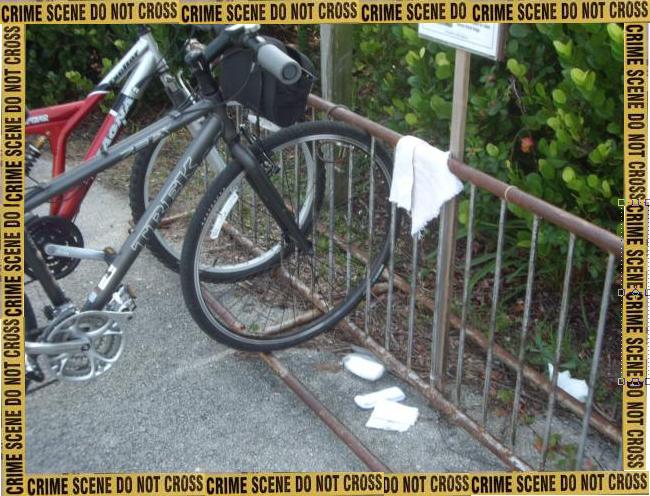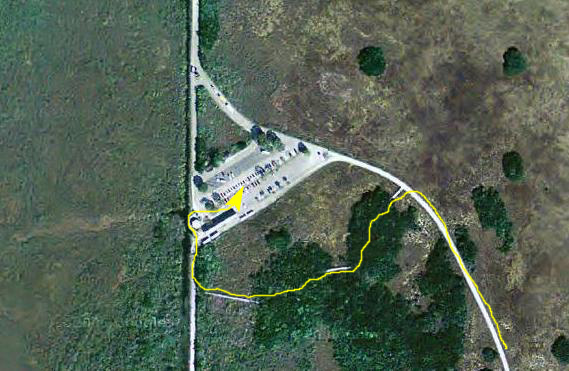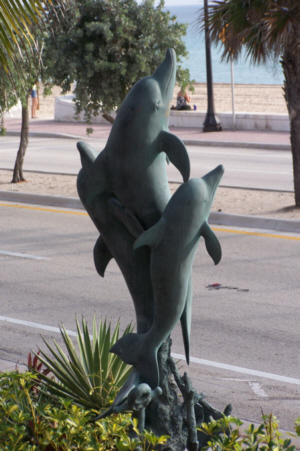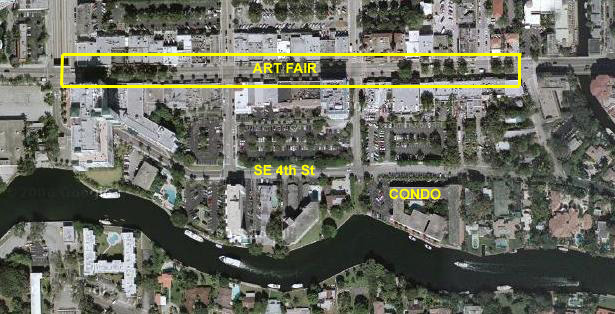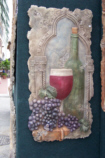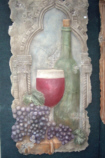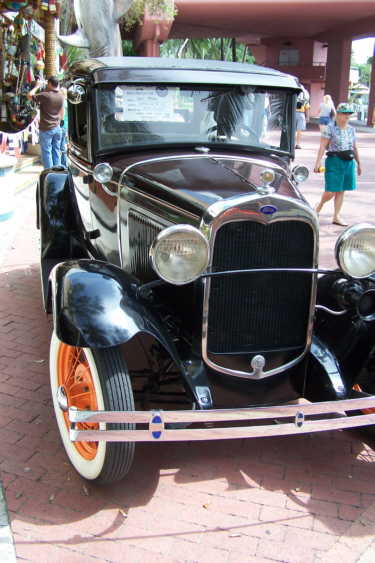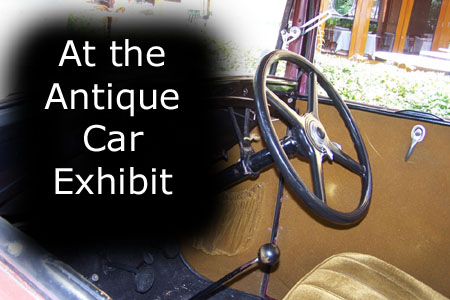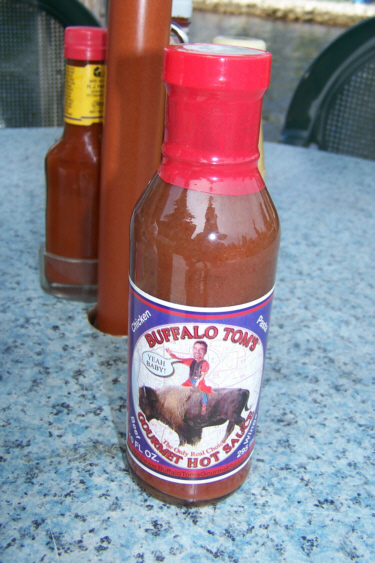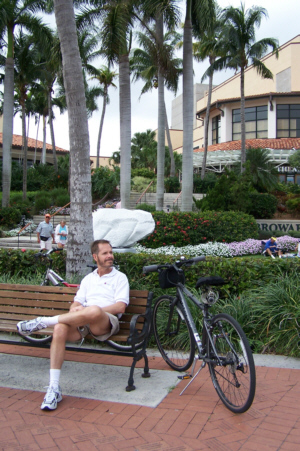We bypassed the bike rental and visitor center for now, and headed down the western side of a 15-mile loop road that is used by bicyclists, pedestrians and trams. You can watch a movie of us just starting out using the player below:
We were looking forward to seeing lots of wildlife, and maybe some alligators. Little did we know. From just a few hundred feet down the road, Fred took a picture of
me looking back towards the trailhead.
You can go either way on the trail, but it is one continuous loop and there are, as they say, only one set of "facilities" at the eight mile mark. Slow walkers be warned.
It became pretty apparent pretty quickly that our trip here to the Everglades to enjoy biking and see wildlife was going to be wildly successful on both counts. The biking was certainly fun, as it always is, but the variety and frequency of wildlife sightings was just incredible. We hadn't gone even a half mile from the Visitor Center before we began to see a wide variety of birds and quite a few alligators- all right by the bike trail- with the alligators so close that you could touch them. Here are some thumbnails for the first pictures we took of the wildlife; click on them to view the full-size images:
|
(Click on Thumbnails to View) |
Here are a couple more good examples of the alligators we've been seeing. First, I took this picture of an
alligator facing away from us
at about the same time as Fred was capturing a
closeup of its head.
Also, I got this shot of
an alligator in the reeds
and then took a movie of the same reptile that you can watch with the player at left. In all these, you can see that what we are looking at are alligators.
A little further into the ride, we came upon another alligator, but this one was only a foot or so from the edge of the road, so we got a really good view of it. You can take a look at the full-size images we captured of this particular alligator by clicking on the thumbnails below; the first two pictures are Fred's, the second two I took.
|
(Click on Thumbnails to View) |
Everglades National Park: A Park for Everyone
We found out that there is a distinction for certain parks around the world that only a select few US National Parks have been given; the distinction is called a "World Park." In the Everglades, earth water, and sky blend in a low green landscape; mere inches of elevation produce distinct changes in vegetation; and where a great wealth of birds and other wildlife find refuge. For this is almost exclusively a biological park dedicated to the preservation of a complex and precisely ordered living mechanism. It lies at the interface between temperate and sub-tropical America, giving a rich diversity of species, many at the limit of their ranges.
World Parks have a unique or rare topography; here, the topography is so subdued that a broad sheet of water slowly flows over and through the porous limestone bedrock on its way to the sea, rather than following well-defined valleys. Most of the park is actually covered with water during normal wet seasons, while dry winters cause fresh water to dwindle to a few open areas crowded with wildlife.
World Parks house wide varieties of flora and fauna. The great floral variety of the Everglades is one of the key resources of the park. Among its more prominent and colorful plants are Bromeliads and epiphytic orchids. As many as 25 varieties of orchids are known to occur in the park, in addition to over 1000 other kinds of seed-bearing plants and 120 species of trees. Over 36 threatened or endangered animal species reside in Everglades National Park, such as the American alligator (Alligator mississippiensis) and crocodile (Crocodylus acutus), the Florida panther (Felis concolor coryi), the West Indian manatee (Trichechus manatus), and the Cape Sable seaside sparrow (Ammodramus maritima mirabilis). Over 300 species of birds have been recorded, seven of which are rare or endangered.
World Parks often have plant and animal species that are extremely rare or endangered. Protection of wading birds and their rookeries from commercial exploitation and encroachments was the prime reason for setting the park aside. Although habitat changes have reduced historic numbers, tens of thousands of birds feed and nest within the Everglades, providing visitors with opportunities of a lifetime for viewing them.
But Everglades National Park is even more that a World Park. It is the ONLY park in this entire hemisphere that has been recognized with all three of the major international park designations.
First, the Everglades has been named an International Biosphere Reserve. These Reserves are a project of the Man and the Biosphere program of the United Nations Educational, Scientific and Cultural Organization (UNESCO). Reserves are protected samples of the world's major ecosystem types. These sites are standards against which we can measure human impact on our environment and predict its probable effects. There are now over 190 reserves in 50 countries. Established for its biological values, Everglades National Park was added to this world list on October 26, 1976.
Second, the Everglades is a World Heritage Site, sites designated by UNESCO under the Convention Concerning the Protection of the World Cultural and Natural Heritage. By the World Heritage Convention's 25th anniversary in 1997, nearly 150 nations had ratified the agreement and placed more than 500 sites on the World Heritage List. The Everglades, a subtropical mosaic of surprising diversity, is a refuge for 13 threatened or endangered animal species. Here, human history spans over 2000 years--from nomadic Calusa to modern settler. Because of this unique weave of natural and cultural history, Everglades National Park became a World Heritage Site on October 26, 1979.
Finally, the Everglades has been designated a Ramsar Wetland of International Importance.
Known popularly as the "Ramsar Convention", the Convention on Wetlands, signed in Ramsar, Iran, in 1971, is an intergovernmental treaty which provides the framework for national action and international cooperation for the conservation and wise use of wetlands and their resources. There are presently 116 parties to the Convention, with 1005 wetland sites, designated for inclusion in the Ramsar List of Wetlands of International Importance. The Everglades was designated as a Wetland of International Importance on June 4, 1987.
Birds in the Everglades
The Everglades is home to a huge variety of wading birds, one of which you can see in the photo at the left. This bird was one of a great many that we saw near the trail as we were biking along.
These particular birds (whose name we do not know) made a particular clicking sound, perhaps to attract other birds or perhaps for some other purpose. Like an idiot, I thought I might be able to attract the bird to come closer by imitating the sound as best I could, but all I succeeded in doing is becoming the silly soundtrack for Fred's bird movie that you can watch with the player below:
The rarest of all the birds we saw was the Wood Stork. We were actually lucky to see one; a park ranger had stopped on the road and seemed intent on something off in the marshy brush. She was the one who pointed the wood stork out to us.
The
Wood Stork
is a large, long-legged wading bird about 40 inches high with a wing span of 60 inches. It is considered to be an "indicator species" in the Everglades because it has rather specific habitat requirements and is closely related with the habitats of other species.
Quality, quantity, timing, and distribution of water in its environment directly determine the well-being and number of this species as well as other species. Monitoring this selected species will reveal much about the health of the entire environment in which it lives.
The
wood stork
is now endangered. It locates food with its bill by groping for small fresh-water fish in shallow water. This method of feeding is best when low water periods develop and the fish concentration increases. Although, due to modern water control programs, excessive drying patterns have created difficulties for the bird. By studying the wood stork, scientists have found that there is a decline in all wading birds in the park since the 1930's by at least 90%.
Below are some thumbnails for some of the many pictures of birds that Fred and I took as we were biking down the road. Click on as many as you wish to see the full-size images:
|
(Click on Thumbnails to View) |
The Everglades Ecosystem
The rock beneath this first national park created to protect a threatened ecological system is just 6,000 to 8,000 years old and in its infancy. South Florida surfaced only since the Ice Age. Nowhere does the Everglades landscape (have a look at this landscape using the player at left)
top eight feet above sea level. And like some low island, this subtropical region enjoys no source of water but the rains that fall on it. Despite all its designations, the Everglades and the endangered species in it may still disappear. Numbers of wading birds nesting in colonies in the southern Everglades have declined 93% since the 1930's. Migrating birds use Everglades National Park both as critical wintering areas and as a stopover, and if it disappears, species like the Cape May warbler, peregrine falcon, bobolinks, and tree swallows will be affected.
Today, extensive canal and levee systems shut off the life-giving bounty of the rain before it can reach the national park, which makes up only one-fifth of the historic Everglades. At times the water control structures at the park boundary are closed, and no water nourishes the wood stork's habitat. Or, alternately, water control structures are opened and unnaturally pent-up, human-managed flood waters inundate Everglades creatures' nests or eggs and disperse seasonal concentrations of the wading birds' prey. Added to these problems is the presence of pollutants from agricultural run-off. High levels of mercury are identified in all levels of the food chain.
Many animals are specifically adapted to the alternating wet and dry seasons. When human manipulation of the water supplies are ill-timed with natural patterns, disasters can results. Alligators build their nests at the high-water level. If more water is released into the park, their nests are flooded and destroyed. Endangered snail kite birds feed on the aquatic apple snail. Low-water conditions, human caused or natural, reduce snail and snail-kite populations. In the early 1960's only 20 to 25 snail kites remained in North America because of prolonged drought. Snails lay eggs above the water in the wet season. If managers release more water, snails fail to reproduce.
Given present trends, the endangered wood storks may no longer nest in South Florida by the year 2020. The wood stork has declined from 6,000 nesting birds to just 500 since the 1960's. Their feeding behavior explains their predicament. Wood storks feed not by sight, but by touch -"tacto-location"- in shallow and often muddy water full of plants. Fish can't be seen in those conditions. Walking slowly forward the stork sweeps its submerged bill from side to side. Touching prey, mostly small fish, the bill snaps shut with a 25- second millisecond reflex action, the fastest known for vertebrates. Only seasonally drying wetlands (mostly in drying ponds)concentrate enough fish to provide the 440 pounds a pair of these big birds requires in a breeding season. When natural wetlands cycles are upset by human water management, wood storks fail to nest successfully.
Native trees, such as mangroves and cypress, are being replaced by exotic (introduced) species from other countries. Florida largemouth bass share their nesting beds with tilapia and oscars, fish imported from Africa and South America. As the Everglades yield to human introduced plants and fish, native species diminish.
Restoration and preservation efforts are underway, but the fate of the Everglades still hangs in the balance. In one of the world's largest ecosystem restoration projects, Congress has extended the park boundaries to protect the eastern Shark River Slough. Historically it hosted higher concentrations of wading bird nesting populations than any other area in the park. The enlargement should help turn around the 93 percent decline these species have suffered by restoring critical, suitable habitat. The National Park and the State of Florida have agreed to be partners in enforcing the existing water quality regulations to address water quality problems. The Park Service is working with the US Army Corps of Engineers and other water management jurisdictions to adopt natural rainfall models of manipulating water supplies.
The park was established to save the Everglades, but real problems continue to beset this landscape. Nothing is saved for good; the Everglades' fate remains our mandate.
Biking Along the Park Road
The afternoon is going quite well. There is plenty of wildlife to see as
I bike along the roadway.
Occasionally, I'll
stop to take an alligator picture
(and here I am
giving the alligator a wide berth,
just in case).
But most of the time, it's just going from one side of the road to the other, looking at wildlife as I ride.
Fred
is also enjoying his ride through the Park; he seems to be able to spot things a little quicker than I, or maybe it's just that he is usually ahead of me. There is a
tram
that takes those visitors who either don't want to or can't ride a bike or walk on a circle tour of Shark Valley; bicyclists are supposed to stop when it passes, as it has just done
here.
I should say a bit about the landscape here at Shark River. Throughout the park, slight changes in elevation (only inches), water salinity, and soil create entirely different landscapes, each with its own community of plants and animals. Generally, the Everglades is a low, flat plain shaped by the action of water and weather. In the summer wet season it is a wide, grassy river. In the winter season the edge of the slough is a dry grassland, as it is now.
As we have ridden along, we have seen what appears to be huge amounts of what looks for all the world like lint covering large areas of the grassland. Actually, this stuff is marl sediment, a calcareous material that settles on the limestone bedrock. The marl allows slow seepage of the water but not drainage. Though the sawgrass is not as tall and the water is not as deep, freshwater marl prairies look a lot like freshwater sloughs.
A freshwater slough is the deeper and faster-flowing center of a broad marshy river. This "fast" flow moves at a leisurely pace of 100 feet/day. Dotted with tree-islands called hammocks or heads, this vast landscape channels life-giving waters from north to south. Everglades National Park contains two distinct sloughs. Shark River Slough, known as the "river of grass," is where we are now. Taylor Slough, a narrow, eastern branch of the "river," and is, of course, east of us. There are no surface connections between the two.
There are also more marine-type habitats, of course, but we are some distance from them, and so won't encounter them today. Today's plants are those of the grassland- grasses and some hardwood stands. One very common plant that we have seen all day is the thistle, shown at right, exactly the same plant that is so prominent in Fred's pasture.
Alligators and Crocodiles in the Everglades
Since we'd seen some reptiles already, we began to wonder what the difference was between alligators and crocodiles. We assumed we were looking at alligators (the Tamiami Trail is also known as "Alligator Alley"). It turns out that they are similar but different. First off, they are from different families of crocodilians. But since you can't ask them their family tree, can you tell by looking?
The easiest way to tell the difference between the two is that a crocodile has a very long, narrow, V-shaped snout, while the
alligator's snout
is wider and U-shaped. Because the alligator has a more powerful jaw, it can eat turtles, in addition to the fish and mammals that form the crocodile's diet.
Another physical difference is that the crocodiles teeth are mostly exposed when the jaw is closed, but
most of the alligators are hidden.
Both crocodiles and alligators have an enormous 4th tooth on the lower jaw (much like the big tooth that you can see in a hippopotamus, but that tooth is exposed in a crocodile but hidden in the alligator.
Finally, crocodiles have a lighter olive brown coloration, while alligators appear blackish, and all the reptiles we saw (and that you can see in all the pictures) were, indeed, black in color, so I don't think we saw one of the relatively scarce crocodiles that make the Everglades their home.
Alligators also prefer freshwater while crocodiles like brackish water and sometimes even ocean. Crocodiles and alligators both have glands on their tongues, but crocodiles still use these glands to excrete excess salt. Alligators seem to have lost this ability, making their tolerance for salt water comparatively brief. Biologists believe this suggests that the crocodile is less removed from its oceanic ancestry.
|
Click on the Image Above to View the Slideshow |
We saw many alligators on our way to the Observation Tower at the halfway point in our bike ride, and I've selected many of the better pictures for you to look at. Since there are so many, I've put them in a slideshow, and that show is at right. You'll see big ones and little ones, swimming ones and sunning ones.
To view the slideshow, just click on the image at right and I will open the slideshow in a new window. In the slideshow, you can use the little arrows in the lower corners of each image to move from one to the next, and the index numbers in the upper left of each image will tell you where you are in the series. When you are finished looking at the pictures, just close the popup window.
Another Close Encounter of the Reptilian Kind
Fred had gotten a bit ahead of me, and I was intent on catching up, so I didn't notice
this fellow
until I was literally on top of him. I think I swerved just a bit, and I guess Fred thought that was amusing, but I'd been looking the other way and was just startled. In any event, this was the closest I'd actually come to an alligator, and while I will cheerfully pass right by the signs on hiking trails that say "Under No Circumstances Go Beyond This Sign," I wasn't about to try my luck by reaching out to touch the alligator; I value my manual dexterity a bit too much.
But I did circle back around to try to capture the close encounter with a short movie, and you can view that movie using the player at left.
The Observation Tower
At about the halfway mark in the ride, right at the south end of the Shark Valley road, is the Observation Tower (marked on the map you saw earlier). The picture at left is a bit misleading; Fred wanted me in the picture of the tower at the end of the road, but didn't want me from behind, so I circled back to go towards him- purely for effect.
When we arrived at the observation tower, we found some bike racks where we could leave the bikes. I would have locked them up, but I didn't think it necessary. We had not passed any people walking in quite some time, although there had been a couple of people on bikes. The tram that was parked at the tower was just leaving, and we knew there wouldn't be another one for an hour. So there was really no one who could take the bikes, at least during the time we would be at the tower itself.
So, putting the bikes in the rack (see aerial view at left), we walked over to the
pathway
leading to
the Observation Tower.
As you can see from these two pictures and the aerial view, there is a circular building built on piers just about twenty feet above the swampy area below. It is in this building that there are some facilities (the only ones on the 15-mile route) and some exhibits.
Then there is a sweeping spiral rap that leads up to the main observation platform. I can only imagine that the ramp was designed to allow handicapped access. On the main platform there is another spiral staircase that leads to an upper platform. It would have been fun to climb all the way up to the top, but the spiral staircase had been closed and locked, perhaps because someone had not been careful sometime in the past.
One of the interesting exhibits in the facilities building was this one that showed the general flow of water through the Everglades.
Before Florida was settled, water from Lake Okeechobee flowed freely- like a slow river fifty miles wide and a few inches deep- and finally merged with the salty waters of Florida Bay and the Gulf of Mexico. This water source was, and is the foundation of Everglades National Park's immensely complex web of life.
The yellow area at the right edge of the state is, of course, the urban area that is made of up of Miami, Hollywood and Fort Lauderdale. The flow of this slow, shallow "river" no longer goes across that area; canals and levees have been built at the western edges of these cities, and these direct such flow as remains to the south and west. The New River in Fort Lauderdale is one of the last remaining outlets of this flow along Florida's East Coast.
Then, in 1962, flood gates along the Tamiami Trail were closed, and the natural flow was blocked. This has had a dramatic effect on the park.
Because the Tamiami Trail and the other east-west highways in the southern part of Florida were absolutely necessary, a manmade system of canals and reservoirs had to be built to allow water to flow under these highways. This system now controls almost all overland flow into the park. But it has meant that large areas of the park that were once swampy have dried out, as water is channeled through certain areas only. In the rainy season, water may still cover those areas, but it is no longer a year-round condition.
We left the exhibit area and began walking up the spiral ramp to the platform. All along the ramp there were excellent views, such as this view of
the tower from halfway up the ramp
and this view of
the tower from the top of the ramp.
As we walked up the ramp, it seemed as if we were being watched; this
crow
kept walking along the ramp railing just ahead of us. The significance of this would become apparent only sometime later.
Here are some more views taken from the ramp- views of the tower and of the surrounding landscape. To view the full-size images, just click on the thumbnails:
The view from the observation tower was really neat.
Looking back up the road,
you can see just how flat the land is here; the flatness is broken only by some of the stands of hardwood trees that grow on the hammocks- which themselves are only a few inches higher than the surrounding land. And behind me, in this picture, you can get an appreciation for why this part of the park is called
"the River of Grass."
We could see in all directions from the tower, and we could get our first look at the eastern side of the bike loop in this
view looking northeast.
In this view of
Fred on the ramp
you can see the road we came down, and the parking area behind him.
Just below us, underneath the observation tower, there was what appeared to be a
small lake,
and we could see a number of
alligators on the shore
as well as one or two
alligators in the water.
The
birds on the shore
seemed to be giving the alligators a wide berth, although I don't think that wading birds are one of the alligator's usual prey.
The Crime
As so often happens when things are about to go terribly wrong, I almost missed the first subtle hint that something was amiss. We were taking pictures from the top of the observation tower, and all seemed well. The sun was shining. The air was warm. There was a gentle breeze.
Perhaps it was that feeling of a finger of cold air gently caressing the back of my neck. Maybe it was that cloud that temporarily blocked the sun. Maybe it was just that sixth sense that we all have when danger is near. Nah. I think it was the guy who walked up to us and asked "Did either of you have anything valuable in your bike bag?"
My first quick thought was that I had been wrong earlier about the safety of the bikes. Perhaps someone had walked down to the bike rack and sped away on my sole transportation. But, no, that didn't make sense. And then, all of a sudden, it hit me. And all of a sudden the presence of the crow earlier, shadowing our every move, watching us as if on lookout- suddenly and in a flash, it all made sense.
We hurried back to the bike and found the unmistakable evidence. My bike bag had been vandalized. But not by the hand of man. No, something much more surprising was going on here- mother nature had taken the odd turn she so often does. I knew I was being watched. I turned slowly, dreading what I would see and there, sure enough, were
the culprits
watching me with their beady little criminal eyes and, I thought, laughing amongst themselves at my consternation.
I was angry at myself that I had totally overlooked the subtle signs that perhaps, just perhaps, I might be inviting trouble by leaving my bike bag unattended. Well, not so subtle, I guess, since the
sign right in front of my bike
said clearly and unambiguously "Do Not Leave Items Unattended."
Well, I'd learned a hard lesson- not to be so trusting in the future. If you want to know what the rest of the sign said, and I think you should, please watch my crime scene movie using the player at left.
The Geology of Everglades National Park
The landscapes we see today in South Florida are a direct result of geologic events of the past. There is no place better to see this than in South Florida's National Parks. Here the geologic record is still fairly intact. Although the activities of humans have altered the landscape somewhat, the overall picture can still be seen.
The rocks beneath the Big Cypress Swamp are among the oldest in South Florida. Six million years ago a shallow sea covered this area. Sediments of silt and sand and particles of calcium deposited on the bottom of this sea gradually cemented into limestone. Today this rock is called the Tamiami Formation. The Tamiami Formation is also found in the northwest corner of Everglades National Park. Here, fresh water flowing out of Big Cypress mixes with salt water from the Gulf of Mexico in a highly productive mangrove estuary. The resulting nutrient-rich soup supports a marine nursery for pink shrimp, snook, and snapper.
Other rocks beneath the Everglades were formed during the time of the Great Ice Age. Although no glaciers developed in Florida, their effects were felt here. As glaciers in other areas of the world expanded, much of the earth's water supply was trapped in the ice. Sea levels in South Florida lowered as much as 300 feet below present levels. The Great Ice Age was actually four shorter ice ages with periods of warming in between. During these warmer "interglacial" stages, the ice melted and returned to the sea. The last interglacial stage occurred about 100,000 years ago. At its peak, the sea level in South Florida rose 100 feet above present levels.
The rocks beneath the southeast section of the Park were formed in this sea. Calcium carbonate settling out of the water coated tiny bits of shell or sand in layer upon layer. The resulting spherical grains of limestone are called ooids. The Atlantic Coastal Ridge which runs from Mahogany Hammock northeast to Miami was formed as long shore currents pushed the ooids up into a long ridge. The ooids later cemented into rock known as Miami Oolite. Miami Oolite also covers most of the area east of Everglades National Park and most of Florida Bay.
In quieter waters covering the central portions of the Park, tiny moss animals called Bryozoans flourished. As they died their calcium skeletons settled to the bottom. These sediments later cemented into rock known as the Miami Bryzoan Limestone.
As in most areas of South Florida, subtle changes in elevation result in dramatic changes in vegetation communities. Pine forests are found on the high ground of the Atlantic Coastal Ridge. Where fire has been excluded, pines give way to hardwood hammocks. In wetter areas near the end of the ridge, dwarf pond cypress grow. South of the ridge sawgrass prairies take over again. A narrow band of mangroves fringe the southeast coast, and the shallow waters of Florida Bay today provide an abundant food supply for great numbers of wading birds.
Heading Back to the Trailhead
It's been quite a day, what with all the wildlife- alligators and birds- the observation tower, and even the criminal crows (why can't THEY be endangered?). But it's time to head back. This time, we took the eastern road, which we discovered to be as curvy and serpentine as the western part was straight. There weren't as many alligators here, as the land was drier. But the "River of Grass" was very much in evidence. As we were biking back, we passed one of the
last trams of the day.
Just before the road got back to the parking area, we turned off onto a boardwalk nature trail that led through the marsh and the hammocks. Here, there were a number of exhibits detailing the flora of the Everglades, and taking us through all the various environment types- swamp, grassland and hammock. We walked the bikes along the boardwalk until we got to the road we'd started out on, and then we biked back to the car.
This has been a really interesting and fun afternoon. Next time we are in Florida, we plan to take the bikes over to the west coast and visit the other parts of Everglades National Park. But all we have to do now is load up the bikes and head home.
But before I finish this narrative of our day in Everglades National Park, I'd like to insert one more section on endangered species and what is being done to save them. All except the crows, I hope.
Endangered Species
Threatened, endangered and extinct are words that have become all too common in our 20th century vocabulary. The natural process of species evolution, taking hundreds and thousands of years, has accelerated rapidly since the turn of the century. Today because of man's desire for land and raw materials, his continued pollution and indiscriminate hunting many plant and wildlife species are on the brink of extinction.
Drainage of wetlands, alteration of overland water flow and hunting have all contributed to species decline. The Everglades, once known for its abundant bird life, has seen its wading bird population decline drastically since the turn of the century. The Florida Panther once common throughout the state, today is on the verge of extinction. Within the four National Park areas of Everglades National Park, Biscayne National Park, Big Cypress National Preserve and Fort Jefferson National Monument there are 16 endangered and 6 threatened wildlife species. The mere physical boundaries of a National Park do not guarantee a species survival.
Maintaining harmony between "20th century progress" and wilderness areas requires research, legislation and public awareness. For the last decade the South Florida Research Center, Everglades National Park, has been studying how changes occurring outside the parks influence the fragile areas within their boundaries. Research going on today may lead to a brighter future for many species.
Legislation such as the Endangered Species Act of 1973 has also afforded some measure of protection for wildlife. The Act provided for the classification of wildlife species as "endangered" or"threatened," and mandated legal protection for species so listed. In justification for such protection, the Act also recognized that the various species of fish, wildlife and plants have aesthetic, educational, historical and scientific value.
All of the endangered species in the Everglades are threatened by loss of habitat and alteration of water flow. An endangered species is a species of plant or animal that, throughout all or a significant portion of its range, is in danger of extinction. Everglades National Park is, or was at one time, home to fifteen endangered species. A sixteenth species, the Red-Cockaded Woodpecker, disappeared from the park in the 1940's.
All of the rare and endangered species are threatened by loss of habitat and alteration of water flow to the park. The survival of these species is a major focus of the park's research effort. When active population management (such as captive breeding or reintroduction) is necessary, the Park Service joins forces with other wildlife agencies.
Endangered Species in Everglades National Park:
Reptiles:
American crocodile (Crocodylus acutus)
The American Crocodile is a lizard-shaped reptile which ranges in length between nine inches (at hatching) to fifteen feet (23cm - 4.6m). The crocodile is slimmer than the alligator, and has a longer, more tapered snout. The crocodile feeds primarily on fish, although it is an opportunistic feeder and will eat almost any animal that comes into its territory. Crocodiles in Florida inhabit the coastal mangrove swamps, brackish and salt-water bays (including northern Florida Bay), creeks, and coastal canals. It is unlikely that any will remain outside the park within five years.
Green turtle (Chelonia mydas)
Atlantic Ridley turtle (Lepidochelys kempi)
Atlantic hawksbill turtle (Eretmochelys imbricata)
Atlantic leatherback turtle (Dermochelys coriacea)
Birds:
Cape Sable seaside sparrow (Ammodramus maritima mirabilis)
Snail (Everglades) kite (Rostrhamus sociabilis plumbeus)
Wood stork (Mycteria americana)
Arctic Peregrine Falcon
Southern Bald Eagle
Red-cockaded woodpecker (Picoides borealis)
Mammals:
West Indian manatee (Trichechus manatus)
The Manatee, or sea cow, is a massive, thick-skinned mammal with paddle-like forelimbs. It is grey-brown in color, weighs between 790 and 1,190 pounds (360 - 540kg), and is eight to fifteen feet in length (2.4 - 4.6m). Manatees inhabit slow-moving rivers, shallow estuaries, and salt water bays where they feed on aquatic vegetation. They are essentially gentle animals and have been used as agents for aquatic weed control. The survival of the manatee has been threatened due to propellers of boats, vandal attacks, poaching, and habitat destruction.
Florida panther (Felis concolor coryi)
The Panther originally occurred throughout most of the southeastern United States, but due to expanding urban development, it has been virtually eliminated. Panther sightings have been reported in some southeastern states, but probably do not exist in any of the eastern states except Florida. The Florida panther is a large, long-tailed, pale brown cat, which may be up to six feet (1.8 m) in length. The panther families usually contain only two or three young, and panthers breed only once every two or three years. Panthers are nomadic animals that have the ability to travel up to twenty miles (32 km) in one journey. They feed primarily on deer and wild hogs; however, some, particularly the younger cats, feed on smaller animals. It is believed that fewer than 50 survive.
Key Largo wood rat (Neotoma floridana smalli)
Key Largo cotton mouse (Peromyscus gossypinus allapaticola)
Insects:
Schaus swallowtail butterfly (Papilio aristodemus ponceanus)
Friday, March 2
Today was a lazy day in Florida. Not that we were all tuckered out from riding through the Everglades yesterday, but we just didn't have much on the schedule. We went by Lauderdale Cyclery and I ordered a second bicycle like mine; it will be much lighter and easier to put on and take off the bike carrier. I will keep Fred's current bike as a third one, and get rid of my old one.
We did some other errands, and also went down to the beach to
play backgammon
and enjoy the afternoon. Also as usual, late in the afternoon we took our frozen drinks down to the dock where, also as usual, Fred snapped a couple of pictures of the river traffic, including
a really handsome sailboat
and
one of the dinner cruises.
Then, for only the second time during our stay, we went out to one of our favorite haunts for cocktail hour, had dinner at a different barbecue restaurant, and then went out again later.
Saturday, March 3
Breakfast on the Beach
During the week, we'd scouted out places where we might go to have breakfast on the beach this morning, and we'd settled on The Deck, a restaurant towards the north end of Fort Lauderdale beach. The Art Fair was going on today, so most of Las Olas was blocked off, but we can always get in and out along SE 4th Street. We drove over to the beach and then headed north on A1A, and Fred took a couple of pictures of the early morning beachfront as we were driving along. You can see those pictures
here
and
here.
As we approached
the restaurant,
I stopped to let Fred out while I went to park the car on a side street.
The Deck Restaurant
was a pretty nice place, with a balcony patio overlooking the beach- just the kind of place we had been looking for. The menu was pretty varied and the prices were reasonable, so I suspect we will come over here again. We got seated pretty quickly, although the restaurant was pretty busy, and we had a good table with a great view (including the dolphin sculpture seen at the left). You can watch a movie I made here using the player below:
I took my own pictures while
Fred studied the menu;
we ended up getting our usual omelette and pancakes. The breakfast was good, and we spent a few minutes walking along the beach walk when we finished (and when we finished, there was quite a line forming at the restaurant).
On the way back to the condo, while driving along Las Olas, Fred snapped a few pictures of some of the finger island canals on his side of the street, and you can view the full-size pictures he took by clicking on the thumbnails below:
As we were turning back into SE 4th Street (Las Olas having been blocked off), Fred caught the
Art Fair Trolley
dropping off some people. The trolley is used for various events along Las Olas; for the Art fair, it shuttles people from the parking areas further east to this point where the Art Fair begins.
The Las Olas Art Fair
It seems as if at least once a year when we come down to Florida, we hit just the right weekend for the Las Olas Art Fair. I suspect that this is the sixth or seventh spring Fair (it is held twice a year) that we've been fortunate enough to attend.
The Art Fair is held along Las Olas Boulevard from the Cheesecake Factory on the west (right over the Kinney Tunnel) to the intersection of SE 4th St and Las Olas on the East (if it went any further, we wouldn't be able to get in or out of our neighborhood). All the cross streets are blocked off, and the vendors' stalls are set up in two rows, back to back, on top of the median down the middle of Las Olas. The Fair is always absolutely full, and sometimes there is a bit of overflow into the side streets. The Fair is always fun to attend- and easy, too, since it is only a block from the condo.
After we got back from breakfast, we took our cameras and headed over to Las Olas. There were quite a few vendors with some interesting things, and each of us made a purchase or two. I got some new artwork for the condo and also paid for some ceramic tiles on which the artist puts whatever picture(s) you send him. Then you can either mount them on a wall, display them in a holder or even use them for trivets. Fred found a neat buffalo picture/artifact (a picture with a relic below it, both mounted in a shadowbox frame). That I purchased and put away for a future gift. But he found some other stuff, too.
|
Click on the Image Above to View the Slideshow |
We took quite a few pictures at the Art Fair. I won't try to describe all of them, since most of them are just random pictures of the Fair itself, some of the items being sold or the surrounding area to the Fair. You will note in this section of pictures one shot that appears to be a row of dolls. Actually, if you send the artist a photo of a person, and then some information about their interests or perhaps how you would like them dressed, he makes the doll figures to order. It would be fun to see what he would do with pictures of myself and Fred, but in the end I decided not to find out.
I've taken a selection of our pictures and put them in a slideshow; since there are fifteen or so of them, this will be an easier, quicker way for you to look at them.
To view the slideshow, just click on the image at right and I will open the slideshow in a new window. In the slideshow, you can use the little arrows in the lower corners of each image to move from one to the next, and the index numbers in the upper left of each image will tell you where you are in the series. When you are finished looking at the pictures, just close the popup window.
Fred is often intrigued by architecture, and there is a
courtyard building
with a nice
fountain
in the middle of one of the blocks along Las Olas, and he stopped to take some pictures. You can see another one of the building
here.
We'd been wandering around the Art Fair for a while, and then we ran into Jack Fontaine, my neighbor from two doors down at Riverview Gardens. Here's a picture of
Jack and I,
and here is a picture of
Fred and Jack.
There was someone else we ran into that I thought should be in a picture with Fred, and you can see Fred and that someone
here.
I should probably note here that about a week after we returned from Florida, Jack called me and said he'd put his condo up for sale. I was surprised, but he explained that since he'd had his dizzy spell and been in the hospital, he was worried about being alone, and so had put down a reservation on a unit at John Knox Village. The Village is a family-friendly place up north of Ron Drew near I-95. When you move in, you sign over, I guess, all your assets to them and in return you get a place to live, in perpetuity, and free, 24-hour monitoring and care by their medical personnel. I don't think hospital stuff is included, but at least, Jack thought, he'd never have to worry about not being able to call for help when need be. We'll be sorry to see him leave Riverview Gardens, but all things change, I guess.
There was another artisan's interesting exhibit that we took a number of pictures (not many of them good) of, and that was the
Pozzobonelli "sculptures."
These look like stone slabs that might have been taken from the side of an ancient building- perhaps in Greece, Rome or Egypt. In reality, they are composites. They are shaped and cracked to look very old, but are actually quite light and very sturdy (the cracks being part of the artwork). I could imagine them in gardens or in certain settings within homes or businesses; actually, we thought of Prudence when we saw them. In any event, we took some pictures of them, and they might be of interest to you. Just click on the thumbnails below to view the full-size images, and ignore the fact that Fred seemed only to be able to catch me with my eyes closed:
It was fun wandering around the Art Fair; when we got back to the beginning, we made note of the stalls we might like to return to the next day and we went back to the condo. We had been invited by Ron and Jay to have dinner at their house, but we had some time before then, so I did a stint on the exercise bike while Fred surfed the Internet, and then we had our frozen drinks down by the dock. Fred got an amusing pictures of some passengers on one of the passing boats evidently reprising
Winslet and DiCaprio in "Titanic."
The dinner at Ron's house was really great. They fixed steaks and all the trimmings, and we were joined by their roommate, John and also by Ron's old friend Tom from Tampa (who had been in Palm Beach to see his heroine, Suze Orman). They really went all out, and we certainly appreciated it.
Sunday, March 4
Antique Cars on the Riverwalk
Well, it's our last day here, which is always a day of mixed feelings. It is so nice to be down here that you hate to go home, but you've been away from home for a while and are anxious to get back. Yin and yang, I suppose. Today we'll be biking along the Riverwalk and over to Shirttail Charlie's for lunch, and then revisiting the Art Fair to make some purchases and look at a few different things.
We biked down through town and then over to the Riverwalk, and we found that in front of the Briny Grill and Pub there was apparently a small (eight cars or so) antique car show going on. We stopped here for quite a while so that we could get a look at all the cars. You can get an idea of what the small show was like by watching Fred's artistic movie of the car show (you'll see what I mean by "artistic" when you watch it with the player below:
|
Click on the Image Above to View the Slideshow |
We also took quite a few pictures, and although you may not want to view them all, you can look at as many of the full-size images as you want. To make that easy, I've put them in a slideshow.
To view the slideshow, just click on the image at right and I will open the slideshow in a new window. In the slideshow, you can use the little arrows in the lower corners of each image to move from one to the next, and the index numbers in the upper left of each image will tell you where you are in the series. When you are finished looking at the pictures, just close the popup window.
Lunch at Shirttail Charlie's
One of the reasons why we rode our bikes over here rather than walked is that it is a lot quicker and easier to get over to Shirttail Charlie's on the bikes. So we left the antique cars and crossed the Andrews Street Bridge to
Shirttail Charlie's
on the other side of the river.
On the first Sunday of the month, there is an open-air concert in the park surrounding Old Fort Lauderdale, and from across the river we could
see
and hear the concert. You can watch my movie of the concert using the player below:
There were
people picniking
all along the river from the Riverfront Center
all the way to the Performing Arts Center.
Taken from
our table at Shirttail Charlie's,
here is
Fred with Old Fort Lauderdale behind him.
Like Fred, I took a movie of the concert going on over on the other side of the river, and you can watch my movie with the player at left.
While we were waiting for our lunch to arrive, both of us snapped quite a few pictures from our vantage point by the river, and I wanted to include some of them here. Across the river, behind Riverfront Center, there is a
new building going up,
and the interesting thing is that down here in Florida the same tradition of putting a tree atop a new building to indicate that it has "topped out" is followed, with the exception that most other places a Christmas tree is used, while here they use potted palm trees!
From our vantage point, we could get a good view of
River House
and a good view of
Riverfront Center
with the train bridge up (as it usually is) in the foreground. Fred also took a nice picture of a
typical New River scene,
of special interest because of the seagull perched on the piling.
I took two similar but different pictures of Fred at the end of the dock at Shirttail Charlie's with downtown Fort Lauderdale in the background, and you can view those pictures
here
and
here.
And, finally, here
I am enjoying the day and the music.
At the Performing Arts Center
After lunch, we rode the bikes back across the river and then around Old Fort Lauderdale, in front of the Science Museum and to the Performing Arts Center. There, we found some benches where we could sit and enjoy the afternoon and the music. At the Performing Arts Center, as you may have seen before, there is a very nice
promenade along the river,
and today there were a lot of people out because of the concerts. Looking in the other direction, you can see one of the newest condominiums on the river,
The Symphony,
which is actually in a great location, right at the bend in the river, right at the end of the Riverwalk, just ouside downtown, adjacent to the cultural center and, at least from the upper floors, with excellent views in most directions. Across the river, just up from Shirttail Charlie's is
another condominium,
a good deal older, whose name I always forget. And looking upriver is a bridge we don't see two often,
the Davie Boulevard bridge.
Just before we left to head back, I got Fred to sit beside the river, with the Arts Center promenade and downtown Fort Lauderdale in the background, and you can see that picture
here.
We walked our bikes most of the way back around the promenade and through the concert area, and then were able to ride them home from the area where the antique cars were.
A Final Visit to the Art Fair
We needed to go back to the Art Fair because I wanted to pick up some things we'd seen the day before. I got a couple of new pictures for the condo which I will have framed when I am back down here next month. I also picked up a buffalo picture to add to Fred's collection; it will be a birthday or Christmas gift sometime in the future. Fred got some very pretty photo tiles to hang in his kitchen, and I placed an order that will allow us to send the artist some of our favorite pictures so they can be transferred to ceramic tile.
Fred took some final pictures while we moved around the Art Fair today, and you can see the full-size images if you click on the thumbnails below:
|
(Click on Thumbnails to View) |
We Head Home
Our flight was at six, so we had a bit of time to get ready. As I said, I hate to leave but am always glad to get home. The flight was a good one, and Greg picked us up at the airport here in Dallas, and we ate at Don Pablo's on the way home. All in all, another excellent trip.
You can use the links below to continue to another photo album page.
 |
March 10, 2007: Spring Arrives at 7011 Inwood |
 |
February 16-19, 2007: Visiting Guy at Ruckman Haus |
 |
Return to Index for 2007 |






